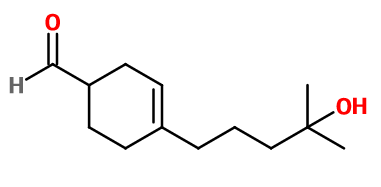
Photo credits: ScenTree SAS
Lyral®
Kovanol® ; Leerall® ; 4-(4-hydroxy-4-methylpentyl)cyclohex-3-ene-1-carbaldehyde ; Cyclohexal ; 4-(4-hydroxy-4-methylpentyl)-3-cyclohexene-1-carboxaldehyde ; Kovyral ; Landolal ; Lanyral ; Lydoucal ; Lysinal ; Mugonal

Photo credits: ScenTree SAS
| Company | Ingredient Name | ID | Comments | Naturality | Certifications | MOQ | Purity |
|---|---|---|---|---|---|---|---|
|
|
Lyral® - 30gr | - |
Visit website
|
- | - | - |
General Presentation
-
CAS N° :
31906-04-4 -
EINECS number :
250-863-4 -
FEMA number :
Donnée indisponible. -
FLAVIS number :
Donnée indisponible.
-
JECFA number :
Donnée indisponible. -
Volatility :
Heart -
Price Range :
€€
Physico chemical properties
-
Appearance :
Colorless liquid that crystallizes at room temperature -
Density :
0,995 -
Refractive Index @20°C :
1,486 - 1,492 -
Optical rotation :
Data not available. -
Vapor pressure :
0,01 hPa @20°C -
Flash Point :
105°C
-
Molecular formula :
C13H22O2 -
Molecular Weight :
210,32 g/mol -
Log P :
2,08 -
Fusion Point :
-20°C -
Boiling Point :
121°C -
Detection Threshold :
0,1 ng/l air
Chemistry & Uses
Uses in perfumery :
Lyral® is used in floral notes such as white flowers, lily of the valley, lilac or lily.
Year of discovery :
Discovered in 1958. Patent N°868,850 published on May 8, 1958 by IFF
Natural availability :
Lyral® is not available in its natural state.
Isomerism :
The positional isomer that is formed during the synthesis of Lyral® has no great olfactory difference with Lyral® used in perfumery. Geranyl Propionate is a constitutional isomer of Lyral®. Their smell is very different as Geranyl Propionate is much rosier.
Synthesis precursor :
Lyral® forms Schiff bases in the presence of amino compounds such as Methyl Anthranilate or Indole.
Synthesis route :
Lyral® is synthesized by a Diels-Alder reaction between Myrcenol and Acrolein (or Propenal) in the presence of a Lewis catalyst such as zinc chloride. When this reaction is performed without a catalyst and at a high temperature, it results in the formation of a mixture of two positional isomers of Lyral®, although Lyral® is still predominant (70%).
Stability :
Aldehydes may form diethylacetals in alcoholic perfumes, with no real impact on their smell.
Other comments :
Lyral® was subject to a recall procedure in 2019, and its use will be banned in 2021.
It is one of the 26 allergens in perfumery.
Regulations & IFRA
Allergens :
This ingredient does not contain any allergen.
IFRA 51th :
This ingredient is restricted by the 51th amendment
- Quantitative limit on the use :
-
Cat.1 Cat.2 Cat.3 Cat.4 Cat.5A B C DCat.6 0,02 % 0,02 % 0,1 % 0,2 % 0,2 % 0,2 % 0,2 % 0,067 %0,2 % Cat.5A B C DCat.6 0,2 % 0,2 % 0,2 % 0,067 %0,2 % Cat.7A BCat.8 Cat.9 Cat.10A BCat.11A BCat.12 0,02 % 0,02 %0,067 % 0,2 % 0,2 % 0,2 %0,067 % 0,067 %91 % Cat.10A BCat.11A BCat.12 0,2 % 0,2 %0,067 % 0,067 %91 %
-
Restricted ingredients: notes
The restrictions as given for the individual categories are not based on the Quantitative Risk Assessment (QRA) methodology but solely represent a pragmatic approach to address the specific situation for 3 and 4-(4-Hydroxy-4-methylpentyl)-3-cyclohexene-1-carboxaldehyde (HMPCC).


